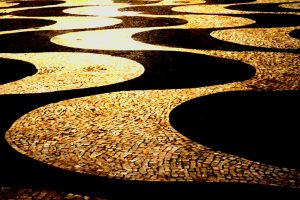As a painter, Roberto Burle Marx was an international abstract expressionist. But as a garden designer and landscape architect he showed a high degree of sensitivity to context – I say ‘surprising’ only because I was so slow to appreciate the complexity of this point. His planting was voluptuously Brazilian, like his mother, and Marx could see no reason for using European plants. Nor did he see any reason for the hard detailing to draw inspiration from the land of his father: Germany. Instead, he drew upon the country whose language is spoken in Brazil. The accompanying photograph is of Copacabana Beach – but could just as well have been taken in Portugal. Until I went to Portugal, I thought this amazing design was an example of Burle Marx inventiveness as an abstract painter. I was very wrong.


This rather astonishing piece of Portugese crochet reminds me of the artwork of Damien Hirst? [blog.craftzine.com/archive/2008/04/joana_vasc…]
See also:
1. Damien with his piece ‘The Sacred Heart of Jesus’ from ‘The Death of God’ exhibition.
(Image no17)
2. Damien with his piece ‘For the Love of God'(Image no10)
3. Damien with his piece ‘The Incredible Journey’ from the ‘Beautiful Inside My Head Forever’ exhibition. (Image no1)
[abcnews.go.com/International/popup?id=3234825…]
Not sure where Damien is going with all of this; I wonder if he knows either? His mother’s name is Mary Brennan – does this suggest a troubled Catholic upbringing as ‘the major influence’ for the UK’s wealthiest artist?
It is interesting that his musings through art have struck such a public chord.
What did you discover about Portugal in your travels that made you reassess the inventiveness of Burle Marx?
Sorry to be slow in responding. Before visiting Portugal I did not know that the ‘snakeskin’ paving pattern shown in the above photograph is a common paving pattern in Portugal, so that Burle Marx must surely have copied it from Portugal (I would like to know how old the pattern is and how it came into being). With regard to context-sensitivity, Burle Marx could have argued that he was responding to the ‘Portuguese’ culture of Brazil but he could not have argued (as he could for his use of plants) that he was responding to the something intrinsically/geographically Brazilian.
As a painter and designer he might have copied the ’snakeskin’ paving pattern from Portugal and translated it into his big landscape promenade in Copacabana and this amazing design is not an example of abstractionism ,but as a landscape architect he succeeded in showing a degree of sensitivity to context using native Brazilians plants in most of his designs .in” the Gardens of Roberto Burle Marx “ by Sima Eliovson ,Roberto admitted that he borrows from the past specially Japanese asymmetrical compositions and he sees the best of cultural arts and take the landscape as a point of departure to produce original works of his own. His artistic work might be a copy of other cultures arguing that is purely Brazilian .however, his holistic use of native plants is no matter what a good example that most landscape architects should take into consideration especially when dealing with sustainability and climate change issues.
Yes, I agree about his contextual use of native Brazilian plants – and this is unexpected in an Abstract Artist. Generally, I think it is true to say that Abstract painters admired science and took the view that if the principles of science are true everywhere then Abstract art is appropriate everywhere. Do you think there are national characteristics in Abstract Art?